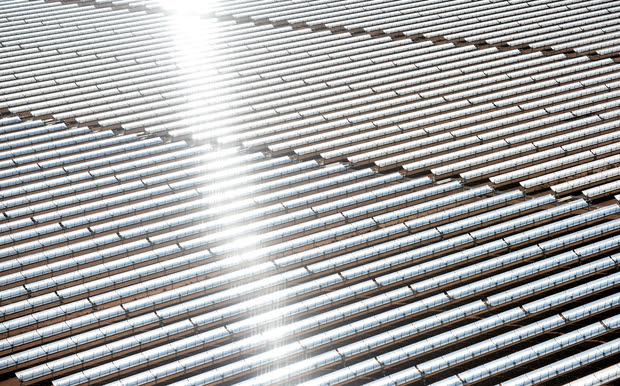Middle East Eye
Kieran Cooke
#InsideMorocco
![[ An aerial view of the solar mirrors at the Noor 1 Concentrated Solar Power (CSP) plant, some 20km (12.5 miles) outside the central Moroccan town of Ouarzazate (AFP) ] Noor](http://www.moroccotomorrow.org/wp-content/uploads/2016/03/Noor-300x187.jpg)
State’s Noor solar plant could power the drive for a network of similar projects to produce plentiful energy for a growing region.
For years solar engineers have dreamed of establishing a network of solar power stations across the Middle East and North Africa, pointing to the region’s two great assets – plenty of space to build solar installations and abundant sunshine to power them.
One step towards achieving that vision was achieved recently when Morocco began operating its 160 MW Noor 1 solar power plant near the city of Ouarzazate, on the edge of the Sahara about 190km from Marrakech.
Noor 1 uses half a million mirrors placed over a vast area of desert to power its turbines, and will supply electricity to thousands of homes in Ouarzazate and adjoining areas.
When the next two phases of the more than $3bn project are completed in 2018, it is hoped it will supply more than 15 percent of Morocco’s total electricity needs and power more than a million homes.
While Morocco has established itself as a world leader in solar power – and polished its credentials as host in November of the next round of global climate change negotiations – the Noor project, like similar schemes across the region, has had considerable problems.
Initially, the Noor scheme was part of a much wider plan put together by Saudi, German and Chinese companies and backed by a number of mainly European investors to build a number of solar installations across North Africa.
The idea was on a grand scale: a substantial portion of the power generated by a region-wide solar scheme would be exported to Europe. By 2050, planners said, Europe would be importing 15 percent of its electricity needs from solar plants in North Africa.
Political upheaval and regional rivalries intervened, and planners seemed to ignore the fact that the demand for energy in countries in North Africa and the Middle East was growing by the day.
Finding the billions of dollars to establish a regional power network – particularly to build expensive power transmission lines – was a big problem. The lack of enthusiasm of many oil producing states to become involved in renewable energy was also an issue.
The grandiose plan collapsed in 2013, when major investors pulled out due to nervousness about tensions in the region and concerns over whether Europe’s ageing energy infrastructure could handle fluctuating solar power inputs from Morocco and elsewhere.
Nonetheless, the Noor project has gone ahead, funded in large part by international development institutions and the World Bank. Morocco is giving generous subsidies to the plant’s operations.
Rabat is desperate to diversify its energy away from fossil fuels. Morocco’s electricity demand is growing by between 6 percent and 7 percent a year. It is the most fuel import dependent country in the region, importing 95 percent of its energy needs.
Arguments over the Western Sahara largely prevent fossil fuel imports from neighbouring Algeria.
Morocco has big ambitions for renewable energy: several years ago it launched a national renewable energy plan and established a solar power agency.
By 2020, the country aims to generate 40 percent of its energy from renewables – mainly solar and wind. By 2030 it wants to up that proportion to 50 percent.
Noor’s backers highlight the advanced technology the plant uses: its concentrating solar power (CSP) system is more complex than the usual photovoltaic panel system used in most solar plants.
Noor’s mirrors heat liquid contained in pipes which then creates steam which, in turn, drives the plant’s turbines. The liquid in the pipes is also used to heat piles of molten salt: the big bonus of the system is that the salt stays hot enough to store heat, allowing power to be generated at night and on cloudy days.
The disadvantage is that the complexities of CSP technology make it far more expensive than photovoltaic.
Another problem at Noor is finding enough water to both clean the mirrors – which can become less effective due to frequent sand storms – and to act as a coolant.
The World Bank and others have praised Rabat for going ahead with the project: they say that if the plant is successful, other countries are likely to follow Morocco’s lead and, as the technology becomes more widely used, CSP costs will decline.
The plant’s construction has revived talk of a giant solar power grid stretching across the region: Tunisia has announced plans to build ten CSP plants, each capable of generating 200MW.
States in the Gulf are also talking about the potential of solar. A CSP plant has been successfully operating in Abu Dhabi since early 2013.
Speaking at the Noor opening last month, King Mohammed VI of Morocco said he wished to see solar power from his country exported – all the way to Mecca.
Whether the King’s wish is fulfilled at any time in the near future is questionable, but for now at least, the sun is shining brightly on Morocco’s solar power ambitions.







